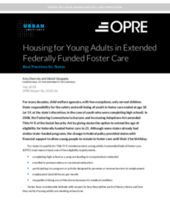Displaying 1171 - 1180 of 2214
This study addresses the needs of Scottish kinship carers of teenage children who have been identified as being in need of extra support.
This study reports the characteristics and needs of 2,045 young people who were under supervision in secure custody or detention in South Australia between 1995 and 2012 according to the level of exposure to the child protection system in an Australian jurisdiction.
The aim of the study was to examine how carers communicate with looked‐after young people about alcohol, tobacco, and drug use.
This paper presents findings from a longitudinal study with seventy-five carers was conducted over twenty months, comparing placements that broke down to those that did not an identifying personal and family factors that increase the likelihood of foster placement success.
In this study, key predictors of trauma were examined using a multi-group analysis of a nationally representative sample of 716 child welfare involved youth ages 11–17.
This qualitative interview study with custodians and young people who have experienced custody transfer highlights that who counts as family and as a parent is ambiguous.
This study from the Special Issue on Adoption Breakdown of the journal of Research on Social Work Practice examines foster care reentry after adoption, in Illinois and New Jersey, USA.
This country care review includes the care related Concluding Observations adopted by the Committee on the Rights of the Child and the Committee on the Rights of Persons with Disabilities.
This study examined educational attainment and earnings among former foster youth in early adulthood.
This brief begins to address knowledge gaps of best practices for housing young adults in extended care, the housing options currently available to those young adults, and how those options vary across and within states in the US.


